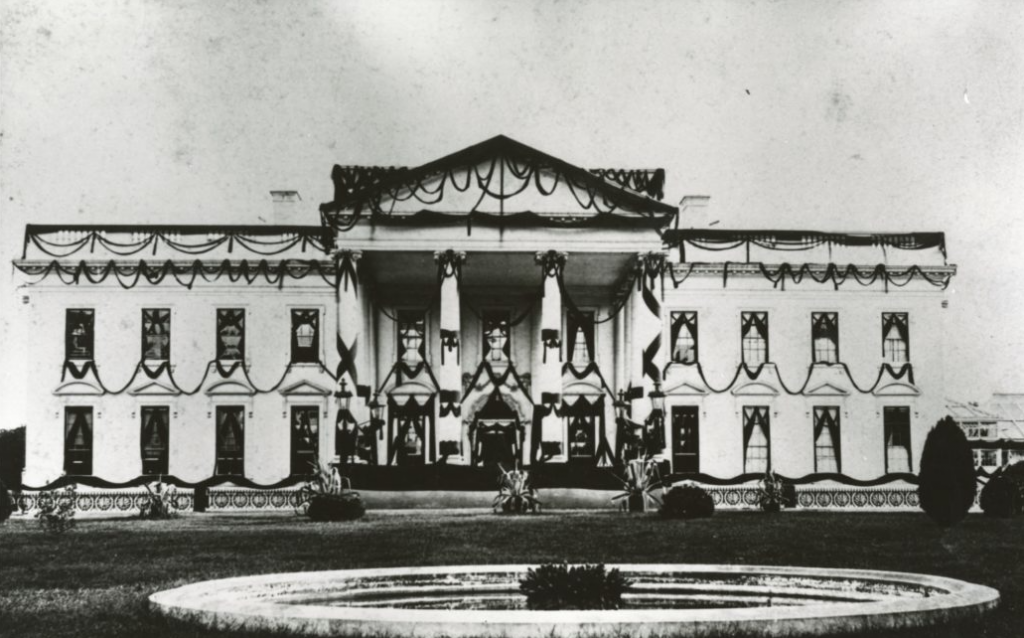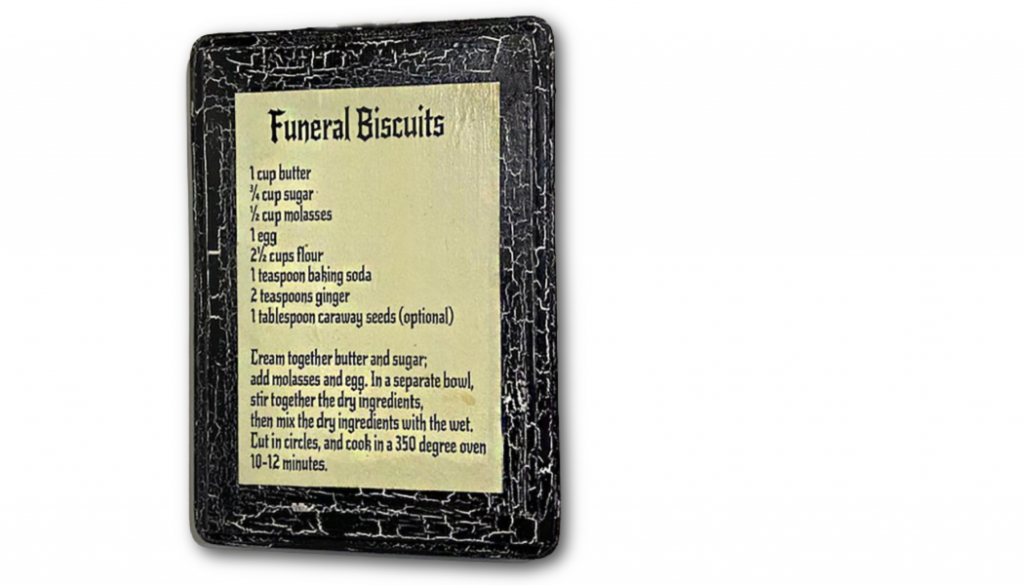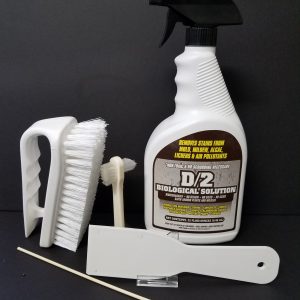Preparing the Victorian home for a funeral was an all-consuming task.
Upper and middle-class families tried to memorialize their loved one’s passing like Queen Victoria herself. And that wasn’t easy. When Queen Victoria’s husband passed away, she remained in mourning for the rest of her life. For forty years she dressed in black and kept mementos in the royal castles as reminders of his death.
In truth, few could afford to mourn as fully as Victoria did, but even working-class families observed modest versions of the same traditions. Some hung black wreaths and others served funeral biscuits. They made do with what they had.

This is the home of Abraham Lincoln at the time of his funeral.

The preparations of a Victorian-era home for a funeral were done by members of the extended family and friends. This gave the immediate family time to grieve.
If your ancestor received an invitation for a funeral, it would have been hand-delivered by a special messenger. Then on the appointed day, they would have put on their Sunday best (but not black mourning clothes because that was reserved for family members) and rode in a horse-drawn carriage to the home of the deceased.
From the front door to the death door (yes, the death door – there really was one), there were reminders in every room that misfortune had come to the household.
Let’s start at the front door . . .
Wreath on the Door
Most wreaths in our day are hung to celebrate Christmas. But it was not always so.
One of the most common Victorian funeral traditions was to hang a wreath on the front door when a family member died.

The wreath let community members know that there had been a death in the household so that they could pass by quietly out of respect. Even children were taught to play on a different street out of ear-shot of a home with a wreath on the door.
Most funeral wreaths were made up of black ribbons or black crepe.

When children died, the wreaths were made up of white flowers.

In Scotland, those who saw a wreath on the door of a home often left a coin at the gate to assist the grieving family.

Toward the end of the Victorian era, the wreath tradition evolved from a funeral decoration to a holiday decoration.
Christmas was celebrated by wiring bright-colored ribbons and ornaments to evergreen wreaths. They were hung as a symbol of the resurrection rather than a symbol of death.
To avoid confusion about whether the family was mourning or celebrating, the placement of the wreaths was important. Funeral wreaths were hung on the front door while Christmas wreaths were hung on the windows.
Black Crepe
It was popular to use black crepe when preparing the Victorian home for a funeral.

Crepe is a lightweight crinkled silk fabric that is processed to remove any sheen.

Crepe was hung above the front door. Then it was tied with ribbons to create a swag.
The color of the crepe and the ribbons gave passersby some information about who had passed away.
Black crepe with a black ribbon meant the deceased had lived a long life. Black crepe with a white ribbon indicated a middle-aged or unmarried adult had passed on. And white crepe with white ribbon was used when mourning children.

The crepe was purposely draped down the sides of the door in order to cover the door knocker or doorbell to prevent visitors from disturbing the mourning family inside the home. Visitors were expected to just knock softly. Sometimes the door was even left ajar so they could just walk in.

Crepe was also wrapped around the doorknob of the bedroom where someone had died.

The entire US White House was draped in black crepe swags for President James A. Garfield’s funeral.

Have you ever hung crepe paper streamers for a birthday party or other celebration? Yours were probably bright colors.

Unless someone was turning 50 . . . then the crepe paper you hung was probably black! Whether you realized it or not, this was done in a nod to a Victorian funeral!
Covered Mirrors
As soon as someone died in a Victorian mansion home, family members or servants rushed around to quickly cover the mirrors with black crepe.
This reflected the Victorian superstition that the spirits of the deceased could enter the mirrors, which served as portals to the “other side”. If it was believed that the mirrors did not get covered soon enough the deceased’s spirit would be stuck in the mirror.

Then the only way to get them out was to break the mirror. (To learn more about Victorian cemetery superstitions click HERE.)
The black crepe remained hanging over mirrors throughout the grieving period.
Ostrich Feathers
Preparing the Victorian home for a funeral required imported ostrich feathers. Lots of ostrich feathers.
Ostrich feather were gathered into plumes and placed in stands.

The plumes were black if the deceased was older.

White ostrich feathers were used for children’s funerals.

Some were dyed pink or yellow.

And then, there were the oh-so-popular black ostrich feather wreaths.
Time Stood Still
When someone died, clocks were stopped at the moment of death. For practical reasons, this would allow for an accurate doctor’s report and death certificate.

But it was also said to be out of respect for the dead. Time had stopped for their mortal life and so their spirit must not be rushed into leaving too quickly by allowing them to notice the passage of time.
When the family’s mourning period had ended, they started their clocks again – symbolic of it being time to move on to another period of their life.
Drapery Backdrop
The Victorian parlor was the room where visiting guests were received but most of the time it sat vacant and unused.

The doors on the parlor were usually kept closed during everyday life. The fireplace sat cold and empty. The furniture was covered with large cloths to keep the dust off and to keep the sun from fading the fabric.
But when the family was preparing the Victorian home for a funeral, the parlor became a beehive of activity. In fact, it required a total transformation of the front parlor.

A portable velvet drapery was set up in the corner of the room or against a wall. It would become the backdrop for the coffin.

The drapery backdrop was unpacked from a suitcase-like travel box and hung on a metal or wood frame. It took at least two people standing on ladders to erect it.
Coffin Stands
Funeral biers were set up in the parlor in front of the drapery backdrop in anticipation of the coffin being placed on them.

Some were made of wood. The inner set of legs could be pulled down and turned sideways to make the stands flat to make it easy to store the biers between funerals.

Other coffin stands were made of metal and had wheels on the bottom.

Some were collapsible and had feet fashioned to look like animal feet.

Other Victorian casket stands were black-painted wooden pedestals with fringed trim. They had metal handles on the top to make them easy to move.
The pedestals were made by the local furniture dealer. The same furniture dealer also built the deceased’s wooden coffin. And by natural extension, the man who built the coffin was asked to be the undertaker. (Click HERE to learn more about the undertaker-furniture dealers of the 1800s.)
Remembrance Cabinet Cards
Cabinet cards were vintage photos or printed messages that were mounted on stiff paperstock.

They were called cabinet cards because they were usually placed in glass-fronted parlor cabinets in remembrance of the deceased. Cabinet cards for the current funeral and from previous services were on display.

Some cabinet cards featured hand-colored pictures of the deceased.
Mourning Sampler

Mourning samplers that had been cross-stitched with names and dates of the deceased were also put on display.
Coffin Plaques
Victorian coffins had silver name plates attached to them.

Sometimes the coffin plaque had a full name, death date, and age.

Other coffin plaques had descriptive titles on them such as “mother”, “father”, or “our darling”.
Long after the wooden coffin decayed, the coffin plaques would remain. They were meant to be a more lasting remembrance even though they were place in the grave.
Flowers
During the Victorian era, it was common to use flowers as a way to send a message to someone. Since it wasn’t deemed proper to speak openly about one’s feelings, flowers were delivered in secret and the recipient had to guess who had sent them.

Even at funerals, flowers were a way for Victorian friends, family, and neighbors to say they cared without having to speak the words out loud. Each bloom was a symbol of a particular emotion.
Here are some of the meanings behind flowers that were gifted at funerals:
- Red Rose: romantic love
- Tulips: friendship and loyalty
- Lilies: the deceased was pure and innocent
- Deep, dark crimson rose: mourning
- Pink carnations: I’ll never forget you
- Marigold: grieving
- Zinnia: lasting affection

There was also a practical side to displaying flowers when preparing the Victorian home for a funeral. It kept the home smelling nice and masked any odors of decay coming from a casket.
Embalming came into common use in the mid-Victorian era. It was primarily used for soldiers who died during the US Civil War and needed to be transported home for burial.
President Abraham Lincoln was the first publicly-renown person to be embalmed and put on view for nearly three weeks.
But prior to embalming, it was important to fill the Victorian parlor with floral arrangements during a viewing and funeral.
Human Hair Home Decor
Victorian funeral preparations would not be complete without using the deceased loved one’s hair to create some home décor.

Families artfully arranged the hair in shadow boxes in the shape of wreaths.

Each flower and leaf that made up the wreath was created from a different individual’s hair.
It could take generations to finish the work of art.

Can’t you just hear them now? “Look there is Aunt Jane’s golden hair in that rose.” or “The dark stems were from Uncle John’s beard.” or “I remember brushing out Susie’s long blond curls that are woven into that leaf.”
Whether we look at this as being fascinating or odd, it was one more way our ancestors made sure they would not forget their beloved family members.
Family Mourning Photos
It was important to Victorians that all the world knew that they were sad to lose their beloved family members. Very sad indeed.
They even made sure to have a photographer come to their home to document their grief. Mourning photographs were placed in photo albums as a remembrance just as one would place wedding photos in an album today.
A Picture to Remember You By
Oh my, oh my! Victorians took photos of their deceased family members after they had passed away. These memorial photographs were then displayed in their homes.
That might seem strange or even creepy for us in our day. It invites both curiosity and repulsion. But for our Victorian ancestors, it wasn’t strange at all. It was just one more of the many ways that they ensured that they would not forget their loved ones.

Hiring a photographer in the early 1800s was so expensive that it was reserved for special occasions such as a marriage celebration, a family reunion, or a funeral.
Many children had not had a photo taken of them during their short life before they suddenly were overtaken by illness and died.
Their parents did not want to forget what they looked like so they had the child photographed post mortem. Often the child was posed to appear as if they were simply taking a nap.

Deceased children were often posed in the arms of their parents. Sadly, this was sometimes the only family photo they owned.
The custom of taking photos with deceased family members became a popular trend. And with the invention of the daguerreotype in 1839, it became even more popular. The daguerreotype made images affordable for families of lesser means.
Photographers traveled from town to town, making home visits for photoshoots. By 1853, about three million daguerreotypes per year were taken in the United States alone.

The deceased person was dressed in their nicest clothing for the photo, as were the other family members. It could sometimes be difficult to tell which person in the picture was not alive.
Post mortem photos were displayed in an upstairs bedroom or in the parlor as the Victorian home was prepared for a funeral.
Death’s Door
Have you ever heard of someone being “at death’s door”? It’s a saying that means some is very sick and likely to die soon.
But death’s door was also a literal thing during Victorian times. Unlike today, when people often spend their final days at a hospital, the Victorians usually died at home.
This posed a unique problem. How does one get the coffin out the door? Hallways were narrow. The coffin was heavy and awkward, long and unbending. It couldn’t be tilted on end.
So some Victorian houses were built with a special door for this purpose. It was called by many names: death’s door, the funeral door, the coffin door, or the casket door.

Sometimes this extra door was on the main floor, exiting from the parlor (or in this case the funeral parlor). The parlor was usually situated in the corner of the house with the most natural warmth and sunlight so families could save on candles and firewood.
Since Victorian homes were typically built on streets that ran north/south or east/west, the parlor was usually on either the southwest corner or the southeast corner depending on which side of the street the house was on.
So the “death’s door” was on the southeast or southwest side of the house, allowing the casket to be carried straight out from the parlor to a hearse parked on the road.

In other homes, the “death’s door” was on the second floor so coffins could be lowered from an upstairs bedroom by pulleys onto a horse-drawn wagon below.
You may have seen older homes that have an upstairs door with no stairs. Perhaps there was a balcony, stairway, or porch there at one time that has since been removed. Or the door could have been for coal deliveries. But in a Victorian mansion, it may have been death’s door.
Funeral Biscuits
The kitchen was a busy place when preparing the Victorian home for a funeral too.
In token of the Christian ordinance of partaking of bread for the last supper, sacrament, or communion, Victorian families baked wafer-like cookies to serve to funeral guests.

They were called “funeral biscuits” and were considered a symbol of the atonement and the hope of resurrection for the deceased.

The funeral biscuits were distributed by the lady of the house as she reached over the coffin and handed them to the visiting guests in her parlor.

Extra funeral biscuits were wrapped in white paper and sealed with black sealing wax to be given to departing guests for those who could not attend.
Pork Pies and Other Pleasantries
Following up to four days of visitations at the home, the burial occurred.
After the graveside service, close family and friends returned to the home of the deceased for a meal.

Pork pies, a large wheel of cheese, and fruit cake were commonly served.
From the Home Parlor to the Funeral Parlor
During the Victorian era, it was considered disrespectful to have a funeral at a funeral parlor. This was only done when someone didn’t have family or friends to take care of the services at home.

But as the Victorian era came to an end, funerals were gradually shifted from the home parlor to the business-run “funeral parlor”. Many are still called that today.
Homeowners began to refer to their front rooms as “living rooms” as opposed to the “parlor” that had formerly been used to layout the deceased.
Modern funeral homes practice many of the same traditions that were widely used when preparing the Victorian home for a funeral. They hang black wreaths, tie crepe swags, set up coffin stands, and display mementos of the deceased.
Learn more about Victorian cemetery traditions by clicking HERE.
Volunteering to Take Gravestone Photos
The BillionGraves app helps preserve family memories. We need your help to take photos of gravestones! It is easy and done completely with your smartphone! Click HERE to get started.

Planning a group service project? Contact us at Volunteer@BillionGraves.com for more resources. We’ll help you find a cemetery that still needs to have photos taken.
You are welcome to do this at your own convenience, no permission from us is needed. If you still have questions after you have clicked on the link to get started, you can email us at Volunteer@BillionGraves.com. We’ll be happy to help you!
Happy Cemetery Hopping!
Cathy Wallace



